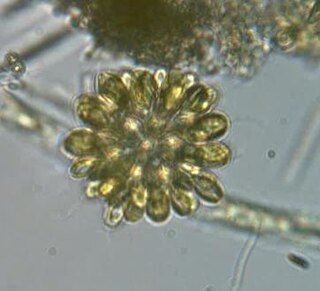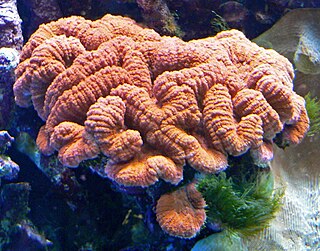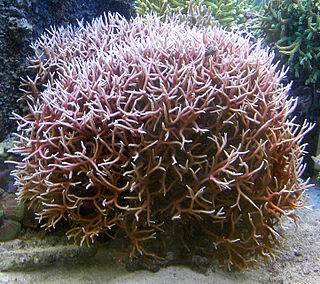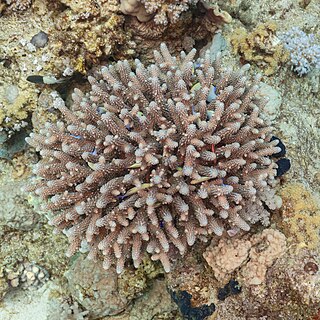
The synurids are a small group of heterokont algae, found mostly in freshwater environments, characterized by cells covered in silica scales.

Christian Gottfried Ehrenberg was a German naturalist, zoologist, comparative anatomist, geologist, and microscopist. Ehrenberg was an evangelist and was considered to be one of the most famous and productive scientists of his time.
Wilhelm Friedrich Hemprich was a German naturalist and explorer.

The sebae anemone, also known as leathery sea anemone, long tentacle anemone, or purple tip anemone, is a species of sea anemone belonging to the family Stichodactylidae and native to the Indo-Pacific area.

The pulsating xenid is a species of soft coral in the family Xeniidae. The species was first described in 1834 by Christian Gottfried Ehrenberg as Xenia fuscescens.

The sooty gull is a species of gull in the family Laridae, also known as the Aden gull or Hemprich's gull. It is found in Bahrain, Djibouti, Egypt, Eritrea, India, Iran, Israel, Jordan, Kenya, Lebanon, Maldives, Mozambique, Oman, Pakistan, Palestine, Qatar, Saudi Arabia, Somalia, Sri Lanka, Sudan, Tanzania, United Arab Emirates, and Yemen. As is the case with many gulls, it has traditionally been placed in the genus Larus. The sooty gull is named in honour of the German naturalist Wilhelm Hemprich who died in 1825 while on a scientific expedition to Egypt and the Middle East with his friend Christian Gottfried Ehrenberg.

Lobophyllia hemprichii, commonly called lobed brain coral, lobed cactus coral or largebrain root coral, is a species of large polyp stony coral in the family Lobophylliidae. It is found in the Indo-Pacific Ocean. In its specific name Christian Gottfried Ehrenberg honoured his late partner the Prussian naturalist Wilhelm Hemprich; they were among the first to study the marine life of the Red Sea.

The lunar fusilier, also known as the blue fusilier or moon fusilier, is a species of marine ray-finned fish, a fusilier belonging to the family Caesionidae. It is widespread throughout the tropical waters of the Indo-West Pacific area.

Acropora millepora is a species of branching stony coral native to the western Indo-Pacific where it is found in shallow water from the east coast of Africa to the coasts of Japan and Australia. It was first described in 1834 by Christian Gottfried Ehrenberg as Heteropora millepora.

Seriatopora is a genus of colonial stony corals in the family Pocilloporidae. They are commonly known as needle corals, birdsnest corals or finger corals. They are native to the Red Sea, the Indo-Pacific region and some parts of the Central Pacific Ocean.

Favites is a genus of stony corals in the family Merulinidae. Members of this genus are native to the Indo-Pacific region and their ranges extend from the Red Sea through the Indian Ocean and Western Pacific Ocean as far as Japan, the Line Islands and the Tuamotu Islands.

Acropora hemprichii is a species of acroporid coral that was first described by Christian Gottfried Ehrenberg in 1834. It lives in reefs at depths of 3 to 15 m for between 13 and 24 years. The species is listed as vulnerable on the IUCN Red List, and has a decreasing population. It is common with a wide range, and is listed on Appendix II of CITES.

Acropora microclados is a species of acroporid coral that was first described by Christian Gottfried Ehrenberg in 1834. Found in marine, tropical shallow reefs on the upper slopes, it is found at depths of 5 to 20 m. It is listed as a vulnerable species on the IUCN Red List, and its population is decreasing. It is uncommon but found over a large area, including in five regions of Indonesia, and is classified under CITES Appendix II.
Anthopleura stellula is a species of sea anemone in the family Actiniidae. It was first described in 1834 by Wilhelm Hemprich and Christian Gottfried Ehrenberg as Actinia (Isacmaea) stellula. It is found in the Indian Ocean and the Red Sea, and is unusual among sea anemones in that it can divide itself in two transversely.

Heterodactyla hemprichii is a species of sea anemone in the family Thalassianthidae, and was first formally described in 1834 by Christian Gottfried Ehrenberg.

Heterodactyla is a genus of sea anemones of the family Thalassianthidae. The genus was first described in 1834 by Wilhelm Hemprich and Christian Gottfried Ehrenberg.

Favites halicora is a species of coral belonging to the family Merulinidae. The species was first described in 1834 by Christian Gottfried Ehrenberg as Astraea halicora.
Tubipora hemprichi is an organ coral in the family Tubiporidae. It was first described in 1834 by Christian Gottfried Ehrenberg. The species name honours Wilhelm Hemprich, and was described from a specimen found in the Red Sea.

Tubipora chamissonis is an organ coral in the family Tubiporidae. It was first described in 1834 by Christian Gottfried Ehrenberg, from a specimen collected near Radack Island.















